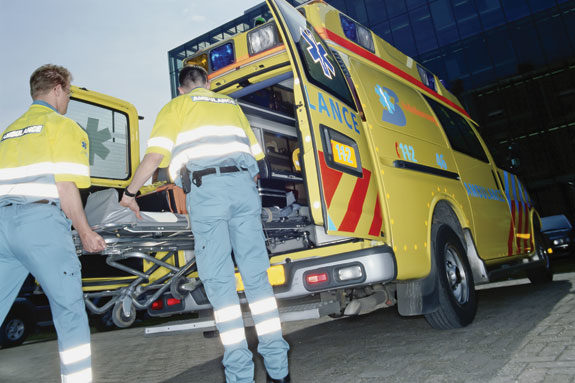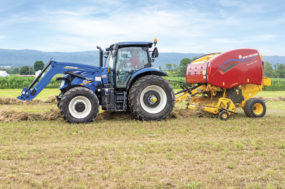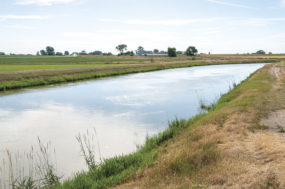The independent hay hauler’s worst nightmare is having something major happen far from home. There is a very good reason that most of the independent hay haulers maintain a good rapport with some of their competitors.
Dan and Darrell make a good pair. Darrell has met Dan halfway and taken his trailers and delivered his load when Dan’s truck decided it was time for a breakdown.
Dan ended up with a whole spare truck over the years, and Darrell used it while his own pride and joy was in for the mechanical equivalent of a heart and lung transplant.
Good things, like bad things, have a habit of coming home to roost. These fellows help each other because they know they will be helped in time of need.
That attitude grows into something much greater than a business working relationship. Dan and Darrell and several others I know are aware of those around them.
It grows into a character trait that seems to thrive more in the rural areas than in the cities. Especially among those who understand and do hard work.
I’ve lost track of the times I’ve been a hero on the road because I possessed a screwdriver and a pair of pliers.
Sometimes a little help is all that’s needed. Sometimes all you can do is make a phone call and know that help is on the way before you leave someone who is stranded with a breakdown.
I remember well the experience of taking apart and repairing the rear axle of the hay truck in a snow bank at Mountain City, Nevada.
I was offered access to every toolbox in town and had offers for the free use of a vehicle if I needed to drive the two hundred miles to the nearest truck parts store.
Years back, I happened on the scene of a major traffic accident. On the scene with a large kit of medical supplies was a truck driver, busily tending to the injured.
I hung around and helped until an ambulance arrived and transported the injured. I spoke with the driver who was tending the injured when I arrived.
He had, on his own, taken the training to qualify as an EMT (emergency medical technician) just because he was afraid of arriving on the scene of a wreck and not knowing what to do to help.
He didn’t want his name in the paper. He didn’t want to even be thanked. “It’s just how I am. I just gotta be able to do something right to help,” was his explanation of his actions.
On that worst day of your life, when you have to call 911 for an ambulance or a fire truck, who comes?
Where I live it will be volunteers from the community who are trained EMTs and firefighters. If your emergency is during the day, someone will have to leave work to come.
One mother will have to call the neighbors to see if one of them is able to stay with her handicapped children so she can respond with the ambulance.
One of our advanced EMTs grows hay with her husband. Sometimes the irrigation water and the balers make responding not possible.
It was the need for an ambulance when her husband was hurt in a farming accident that gave her the “push” to volunteer. Her husband serves with us as a firefighter now, also.
If your emergency comes in the middle of the night, someone who has to be on the way to work at five or six or seven in the morning has to get up and dressed and then gives up an average of four hours of sleep time if transport to the hospital is needed. We could use more volunteers.
One of our volunteers works at the parts store. He cannot leave from work. His voice is regularly heard on the scanner as he and his daughter respond to calls in the night. Work still starts at seven the next morning.
Being part of a rural ambulance service will give you new experiences. Some time back two manure- spreading trucks tangled on a steep downhill slope.
One struck the other from the rear, and both overturned. One of the drivers was pinned under a truck. The manure they were hauling was rather solid, and the pinned driver was caught by the legs between the cab of his truck and the load the other truck had spilled when it overturned.
The driver wasn’t badly injured, he was just stuck. I was a hero that day. Everyone else was wondering aloud how long it would take to get machinery big enough to lift the truck to free the driver.
I inquired about a shovel. We shoveled the semi-solid manure from under the driver until his legs fell free from the pinch-point that had held him. That was the messiest wreck I have ever been on.
The statistics we get indicate that, nationwide, volunteerism is declining. We are feeling that here in central Washington State, and it’s probably an issue in most other rural areas as well.
What does it take to make a difference? To become an EMT takes 120 to 140 hours of class work. To become a firefighter usually takes showing up for training, and after a while they will certify you to drive a fire truck.
While no one is available to volunteer 24/7, all of us have some time that we can drop what we are doing to help when our neighbor is in need.
No one has a lot of free time. We all have some free time. Until you have been there, you will not realize what a comfort it is to the patient and his or her family to know that someone on the ambulance crew knows them personally.
Making a big difference in the life of someone in need is always worth it. If you are served by volunteers, inquire if they too are short-handed. FG











